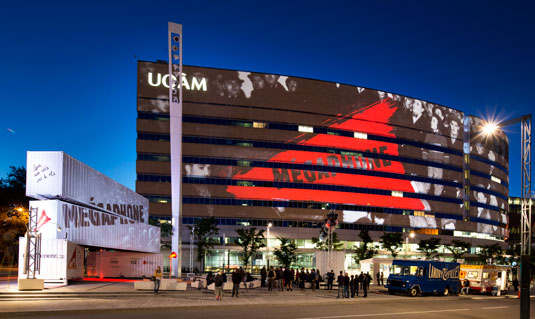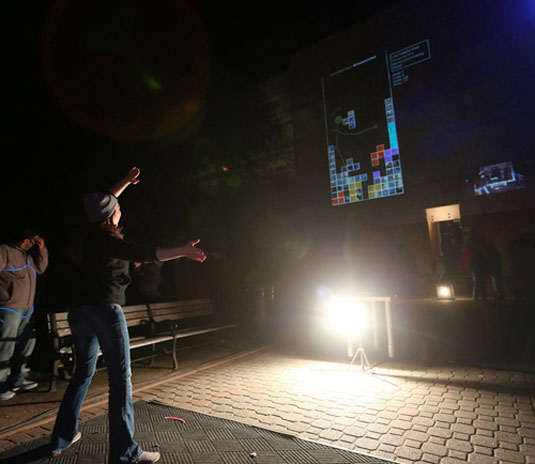

Mégaphone turned public speech into text - in real time - that was illuminated on the front of the UQAM Président-Kennedy building. Photo © Moment Factory
(VANCOUVER, BC) The Promenade des Artistes in Montréal’s historic Quartier des Spectacles was alive with the voices – and the words – of Montréalers in Fall 2013.
Hundreds of citizens had their turn to speak out at Mégaphone – an interactive street exhibit that merged innovative technology and urban space to allow the exercise of free speech in a public forum. Using new media to transform the traditional soapbox, participants had their spoken words converted into text and projected onto the nearby President Kennedy Building of Université du Québec à Montréal (UQAM).
Inspired by Montréal's history of popular assemblies and the Speaker's Corner in London, the installation was co-produced by the National Film Board of Canada (NFB) and the Quartier des Spectacles Partnership, and was a Moment Factory creation directed by local artist Étienne Paquette.
The unique hands-on exhibit became the focus of a ten-week field study by Claude Fortin, a Simon Fraser University doctoral student and GRAND HQP who is examining the aesthetic and social potential of public interactive displays. Mégaphone became Fortin’s doctoral case study after she introduced herself to the Quartier des Spectacles Partnership and offered to collaborate with them in conducting a field evaluation of one of their interactive media façades.
“I consider myself extremely lucky to have had the opportunity to work with the NFB and Montréal’s Quartier des Spectacles Partnership. It took about a year to build bridges with them – collaborations like this are currently not the norm. Little by little, I was able to negotiate a small space from which I became a fly-on-the-wall to study their infrastructure, and eventually, do a full evaluation of Mégaphone.”
Among the many speeches, songs, and thoughtful reflections – including several evenings of slam (in French) and storytelling (in English) – Mégaphone highlights included campaign speeches by Montréal’s mayoral candidates and a discussion by former student leader Gabriel Nadeau-Dubois on the Quebec Charter of Values, which sparked heated debate.
To document the interactions, Fortin interviewed a number of participants.
“Mining rich qualitative data on interactive digital displays ‘in the wild’ requires an approach that favors observation and descriptive reporting based on interpretative analysis,” noted Fortin. “All that sounds good, but without a field to study, it’s just rhetoric. I lucked out with Mégaphone – it turned out to be a gold mine.”
For Fortin, it was a life-changing experience to work with participants from such a diverse range of backgrounds. “It reminded me of how important it is to be close, very close to the people we are designing technology for.”
For Fortin’s doctoral supervisor, SFU SIAT professor Dr. Kate Hennessy, the research is an important extension of the work being done at the school’s Making Culture Lab (MCL) to develop and assess cultural-specific applications of digital media.
“Claude Fortin’s evaluation of the NFB Interactive project Mégaphone, in particular, provides unique insight into the culturally, politically, and economically situated design and implementation of a large scale digital public display, as well as its reception, engagement, and appropriation by the public.”
Dr. Hennessy is the Director of the MCL and a GRAND CNI. Originally joining GRAND through the Greenest Cities Conversations project (GRNCTY) aimed at developing channels for public engagement on sustainability policies, her ongoing work has expanded to the development of digital museum applications through the DIGIKIDZ (Children's Digital Culture) project.
“Claude and I are engaging in research that we feel has potential to be influential across disciplines, both in terms of applied design and scholarly praxis,” noted Dr. Hennessy.
Future of urban spaces: wired and interactive
While today’s public displays are mainly hands-off, Dr. Hennessy and Fortin anticipate interactive media to become an increasingly common feature of public spaces.
Artists and engineers today are envisioning outdoor new media on street corners, in town squares, and at transit stops that will make urban technology — such as networked public furniture, interactive billboards, or architectural-scale displays — centres of attraction for cities. The pervasiveness of mobile computing devices such as smartphones means we may soon be routinely networked in a way that blends the physical and the virtual worlds we occupy.
The Lost Rivers app, developed in part by GRAND researcher Dr. Kim Sawchuk at Concordia University’s Mobile Media Lab, brings this into play by giving urban dwellers a mobile way to rediscover the lost rivers of Montréal. Using GPS-enabled smartphones, the app allows users to reveal historical and geographical landmarks concealed by years of development.
At the University of Calgary's Innovis Lab, Drs. Sheelagh Carpendale and Uta Hinrichs are studying the use of multi-touch tables in public exhibition spaces. Their field study at the Vancouver Aquarium showed how visually interesting and interactive information can evoke visitors’ curiosity and encourage playful, open-ended exploration.
According to Fortin, we will continue to see more and more similar examples of how interactive technology can support offline participation in real public spaces. Through her empirical research, she is seeing new forms of public interaction that leverage online participation and virtual communities. Locative media and interactive installations are bringing people back into public space to communicate face-to-face.
“Digital technology enables us to meet and engage with people in our local communities, people we would otherwise not even know and probably never think of friending on Facebook!” remarked Fortin. “In this sense, I believe that locative media such as digital public displays are helping make the relationship between online and offline technology come full circle.”

The Kinect-based game Tweetris combines social media and public outdoor spaces. Phone courtesy of Dalhousie University.
The award-winning social game Tweetris, for example, co-developed by GRAND researchers at the Digital Futures Initiative (OCAD University) and the Dynamic Graphics Project Lab (University of Toronto) has engaged visitors in live play that takes place in person and on Twitter. The “whole body” Tetris has players contort to match brick shapes shown on a large screen. Snapshots of the players in position are then tweeted to become shapes for another game played in real-time on an outdoor display or on mobile devices.
By closing the gap between online and offline communications, Fortin believes a wider range of opportunities will emerge for people to develop social, cultural and political capital, to improve their life conditions, and to foster a sense of community. And with the advent of so-called “Smart Cities” – technologically enabled urban areas – she sees a growing need for citizens to have a voice in the design of public technologies.
“I see a lot of stakeholders jumping into the mêlée to get onto the Smart City gravy train, but only the artists and issue publics are pushing for tools that are widely accessible and designed for empowerment,” explained Fortin. “As a researcher, I can document their perspective and disseminate it.”
With the Mégaphone installation, Fortin sees possibilities for how cities might support social participation, activism and civic engagement.
“I came to understand the extraordinary potential of media architecture when creative minds and public-private technology partnerships come together.”
Making Culture Lab at the intersection of art and anthropology
Fortin’s inquiry into digital public displays is part of a diverse range of curatorial research at the Making Cultural Lab.
Created in 2010 by Dr. Hennessy, a cultural anthropologist, the MCL specializes in interdisciplinary approaches to multi-sited ethnography and participatory design. Researchers work in close proximity with end users, carefully documenting their feedback on designs and prototypes, and paying attention to what they do from first-hand observation.
The Lab is home to a remarkable series of anthropologically conversant projects involving Indigenous communities and heritage institutions.
The Inuvialuit Living History project, for example, a virtual museum exhibit of the Smithsonian Institution’s MacFarlane Collection, is an ongoing collaboration between the Inuvialuit Cultural Resource Centre in Inuvik, the Smithsonian Arctic Studies Centre, MCL, and other partners. Another project, Digital Uyghur Dastan, led by PhD student and GRAND HQP Aynur Kadir, involves the collaborative design of a platform to archive Uyghur epic poems and oral histories in Xinjiang, northwestern China.
Dr. Hennessy is also a co-founder of the Ethnographic Terminalia curatorial collective, which organizes annual exhibitions at the intersection of anthropology and contemporary art. Their most recent show ‘Exhibition as Residency: Art, Anthropology, Collaboration’ took place in Chicago in November 2013 at the Arts Incubator in Washington Park, bringing together seven teams of artists and anthropologists to realize and exhibit collaborative projects in the gallery space.
In 2013, the work of the MCL was acknowledged with funding by the Canada Foundation for Innovation (CFI) to support the Critical Ethnography and Digital Heritage Initiative (CEDHI), a partnership with Dr. Jan Marontate in SFU School of Communications.
Fortin’s research fits well with the mission of MCL to examine where artistic practices meet social practices, as well as GRAND’s model of interdisciplinary research.
“I feel right at home in this research hub,” said Fortin. “I consider it to be one of the best research groups in Canada where researchers are taught to use ethnographic research methods to both study and make digital media.”
Through GRAND, Fortin has participated in a number of conferences and workshops, including the 2012 Computer Human Interaction Mentoring (CHIMe) Workshop, the 2012 Summer Social Webshop (SSW), the 2013 Digital Societies and Social Technologies Summer Institute, and the Euphoria & Dystopia Symposium sponsored by GRAND and OCADU. Most recently, Fortin took time out from her Mégaphone study to present at the World Social Science Forum 2013 in Montréal.
“The GRAND-sponsored specialized workshops I attended in the U.S. gave me a much better understanding of what the structure of technology R&D looks like,” she said. “[It has put] me in touch with new actors, whether from the academic community or from industry.”
By way of involvement in GRAND, Dr. Hennessy has also seen strong encouragement from colleagues in the network for the Lab’s emphasis on cross-disciplinary collaboration and anthropological approaches to the design and evaluation of digital media. SIAT is one of the few departments in Canada with senior researchers using similar design ethnography and inductive qualitative methods, including GRAND researchers Drs. Carman Neustaedter, Alissa Antle, and Ron Wakkary.
“GRAND has provided an important context for the development of the work of the MCL,” said Dr. Hennessy. “We look forward to developing these relationships and projects further in the years to come.”
-30-
Media Contact:
Spencer Rose
Communications Officer
GRAND NCE